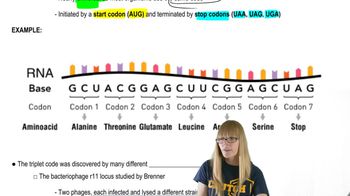Table of contents
- 1. Introduction to Genetics51m
- 2. Mendel's Laws of Inheritance3h 37m
- 3. Extensions to Mendelian Inheritance2h 41m
- 4. Genetic Mapping and Linkage2h 28m
- 5. Genetics of Bacteria and Viruses1h 21m
- 6. Chromosomal Variation1h 48m
- 7. DNA and Chromosome Structure56m
- 8. DNA Replication1h 10m
- 9. Mitosis and Meiosis1h 34m
- 10. Transcription1h 0m
- 11. Translation58m
- 12. Gene Regulation in Prokaryotes1h 19m
- 13. Gene Regulation in Eukaryotes44m
- 14. Genetic Control of Development44m
- 15. Genomes and Genomics1h 50m
- 16. Transposable Elements47m
- 17. Mutation, Repair, and Recombination1h 6m
- 18. Molecular Genetic Tools19m
- 19. Cancer Genetics29m
- 20. Quantitative Genetics1h 26m
- 21. Population Genetics50m
- 22. Evolutionary Genetics29m
17. Mutation, Repair, and Recombination
Types of Mutations
Problem 8b
Textbook Question
Textbook QuestionWhen the amino acid sequences of insulin isolated from different organisms were determined, differences were noted. For example, alanine was substituted for threonine, serine for glycine, and valine for isoleucine at corresponding positions in the protein. List the single-base changes that could occur in codons of the genetic code to produce these amino acid changes.
 Verified Solution
Verified SolutionThis video solution was recommended by our tutors as helpful for the problem above
Video duration:
1mPlay a video:
Was this helpful?
Key Concepts
Here are the essential concepts you must grasp in order to answer the question correctly.
Genetic Code
The genetic code is a set of rules that defines how the sequence of nucleotides in DNA or RNA translates into the sequence of amino acids in proteins. It consists of codons, which are triplets of nucleotides, each corresponding to a specific amino acid or a stop signal. Understanding the genetic code is essential for determining how mutations can lead to changes in amino acid sequences.
Recommended video:
Guided course

The Genetic Code
Point Mutations
Point mutations are changes in a single nucleotide base pair in the DNA sequence. These mutations can lead to different amino acids being incorporated into proteins, depending on the nature of the change. For example, a transition mutation (purine to purine or pyrimidine to pyrimidine) or a transversion mutation (purine to pyrimidine or vice versa) can result in the substitutions noted in the insulin sequences.
Recommended video:
Guided course

Point Mutations
Amino Acid Substitution
Amino acid substitution occurs when one amino acid in a protein is replaced by another due to changes in the corresponding codons. This can affect the protein's structure and function, depending on the properties of the substituted amino acids. Identifying the specific codon changes that lead to these substitutions is crucial for understanding the genetic basis of protein variation across different organisms.
Recommended video:
Guided course

Point Mutations

 9:49m
9:49mWatch next
Master Point Mutations with a bite sized video explanation from Kylia Goodner
Start learning


